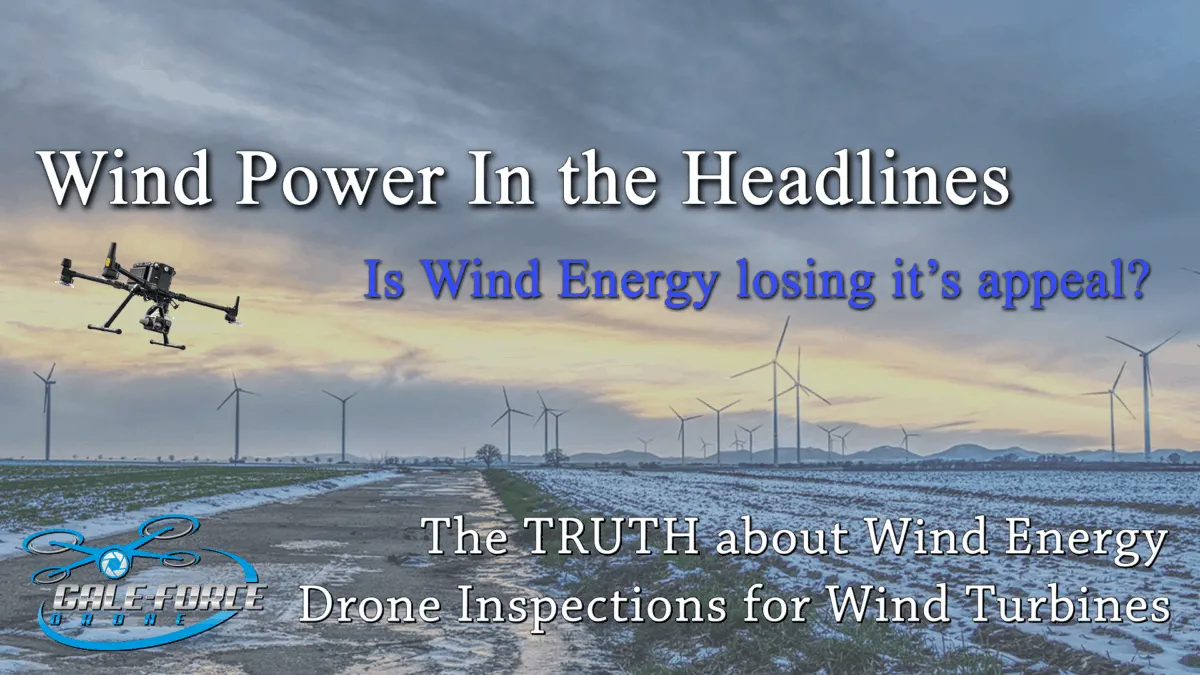
With Renewable energy and environmental responsibility dominating our headlines with the power outages in Texas, wind energy seems to be taking the brunt of the criticism. But have you ever wondered how wind energy actually works? And why we would even use other energy sources? Furthermore, is Wind Power losing it’s appeal? This article explains the background on wind energy, and offers some useful advice for your drone startup business.
Wind is FREE and Wind is CLEAN
It covers almost the entire earth. We don’t have to mine it or transport it, and nobody sets a price on it. And it also creates cheap electricity.
Headlines across the globe are touting a movement toward clean, renewable energy sources, and wind is in the top 3 sources that meet these criteria. This seems like a no-brainer; so why are we still burning fossil fuels when we have all this free energy available?
How Wind Energy Works
With few exceptions (such as electrochemical and photovoltaic cells), most of today’s electricity is generated by simply rotating a shaft. This shaft causes magnets to rotate inside a set of coils, using Faraday’s principles of magnetic induction to produce electrical current. Nearly all major forms of electrical generation are just sophisticated ways to spin the shaft.
If you are like most people, you intuitively grasp the fact that wind causes a turbine to spin, and violá! Electricity. However, the full story is a bit more sophisticated than this, so let’s scratch the surface of how wind energy actually works.
Power Generation
Wind power turbines can generally be grouped into two categories: horizontal-axis turbines and vertical-axis turbines.
 Horizontal-axis turbines are typically what you picture when you think about a wind power turbine. It is a large, usually three-bladed, fan at the top of a tall mast. The fan must be rotated into the wind for maximum efficiency, so there is often a motor to help point it in the right direction. Because the blades are so long, and can be rotated in all directions, these turbines take up a lot of space. Wind farms use a lot of acreage with this type of turbine.
Horizontal-axis turbines are typically what you picture when you think about a wind power turbine. It is a large, usually three-bladed, fan at the top of a tall mast. The fan must be rotated into the wind for maximum efficiency, so there is often a motor to help point it in the right direction. Because the blades are so long, and can be rotated in all directions, these turbines take up a lot of space. Wind farms use a lot of acreage with this type of turbine.
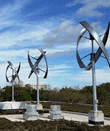 Vertical-axis turbines are generally less efficient than their horizontal counterparts, but they work with wind from any direction, and take up much less space. Their simple and compact design makes them better suited for urban areas.
Vertical-axis turbines are generally less efficient than their horizontal counterparts, but they work with wind from any direction, and take up much less space. Their simple and compact design makes them better suited for urban areas.
Longer blades tend to be more efficient at converting wind energy into electrical energy, but longer blades lead to larger turbines, and larger turbines means that fewer turbines can be built on a dedicated plot of land. Wind farms need to balance their real estate costs with the required electrical power generation.
Wind farms can be land-based or offshore. Offshore wind farms tend to use larger turbines to make use of stronger winds, and there is less competition for real estate.
Stronger winds produce more electricity, but each turbine has a maximum limit of how much power it can produce. Increasing the RPMs above this level not only produces no extra electricity, but it also risks damage to the equipment. Turbines are engineered for optimal operation in the prevailing conditions for their area, and have safeguards in place to minimize the potential for mechanical damage. Excess energy is bled off to avoid overpowering the system.
Power Storage
If wind velocity and electrical consumption stayed constant, then wind power would be a trivial thing–we would simply build enough turbines to match the demand, and electrons would flow at the same rate they are consumed. However, this is not the reality that we live in.
Wind velocities vary from hour to hour, day to day, and season to season. Stronger wind means faster spinning, which means more potential electricity to generate. Similarly, weaker winds produce less potential electricity. If a turbine just isn’t producing enough power, we can’t turn the wind any higher: nature gives us what it gives us. (This is one advantage of fossil fuel powerplants–we can spin the blades faster by adding fuel to the fire.)
Electricity consumption also varies: we go through seasons of higher usage to heat or cool our homes, and new buildings are constructed every year which raise the overall electrical demand. The electrical draw between daytime and nighttime in your home is also affected by how many lights and appliances are running.
Since we have variable power generation and consumption, we need some method to store energy during high-generation periods, so we can trickle it out during low-generation periods. There are four general methods to do this.
- Battery storage. As the name implies, power companies employ massive battery banks to simply store excess electrical energy to be used on a less-windy day.
- Hydrogen cell storage. Excess energy can electrolyse water into hydrogen and oxygen, which are then stored for future conversion back into electrical energy.
- Compressed air storage. Excess energy drives an air compressor that stores pressurized air in a large vat. When additional electricity is needed, this air is released to turn its own turbine to generate electricity.
- Hydroelectric storage. Excess energy drives a water pump to store water in a vat at the top of a hill or tower. When additional electricity is needed, this water is released to drive its own hydroelectric power generator.
It is important to understand that the process of storing electrical energy involves some loss due to inefficiencies: 10 kWh of wind energy pushed into storage will come back somewhat lower, say 9 kWh of usable energy. This is another challenge that fossil fuel generators don’t have to face: potential energy is stored in its carbon-based form until it is needed.
Power Distribution
Once electrical energy is created and stored, it is then metered and distributed to its points of consumption. This is largely accomplished via a network of transmission substations and powerlines that cover our landscape. As with most forms of electrical power generation, it is advantageous to minimize the physical distance between the powerplant and the consumer; in fact, the power grid’s reliability benefits from having a network of powerplants supplying the region.
Economic Impacts
Wind power is among the least expensive forms of electrical generation, provided that it can be scaled to the optimal capacity. Wind does not have to be imported from foreign nations, nor does it have to be transported through pipelines. The land used for large wind farms may be dual-purpose, such as an agricultural field or ranch (which provides rental income for the agricultural land owner). Many countries are offering tax benefits for wind projects, making them more attractive options to power utility companies. It has been estimated that a single wind turbine will reach its break-even point in approximately 10-15 years, including all tax benefits and other financial offsets. This break-even point will diminish over time as we develop more efficient manufacturing and energy storage methods.
With all these benefits, is Wind Power losing it’s appeal? We must remember that wind is not always reliable. We cannot simply produce more wind when we need more electricity–we get what we get. For this reason, wind power is often best-used when coupled with a more stable source of electricity, to carry the base load.
Environmental Impacts
The full environmental impact of any power generation source would require a Masters-level thesis to fully do justice to the complexities of the matter, so we will simply focus on carbon emissions as an indicator of how “green” this energy source is. Of all major power sources, wind power is the second-lowest emitter of carbon dioxide per unit of power produced, losing only to hydroelectric power. In terms of life cycle carbon emissions, wind power is several orders of magnitude lower than fossil fuels. So again, why is wind power losing it’s appeal?
The manufacturing process of the machinery is not terribly different from other industries, and offers no special considerations for assessing the impact to the environment. Battery storage does introduce some nuances, in that most forms of electrochemical energy storage impart some adverse manufacturing and disposal effects on the environment. Perhaps the most understated environmental impact is the sheer size that a wind farm requires: while a conventional fossil fuel plant may only require a few city blocks, a wind farm can take up the same space as an entire city! This is a simple matter for areas of low-density population, but it becomes much more meaningful in urban and suburban environments.
Wind Turbine Inspections - Traditional Methods or Drone Inspection?
One of the leading life cycle costs of operating a wind farm is the recurring inspection requirement. A wind turbine is a complex machine of many moving parts: spinning blades, gearboxes, rotation motors, and power generators all have unique inspection requirements on a recurring basis.
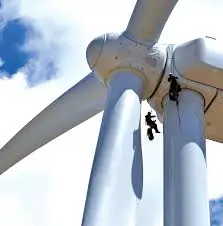 A professionally-trained and certified turbine inspector receives about two years of training to understand the equipment’s operation, inspection tools and data analysis, and safety precautions. His skill set includes climbing, rappelling, high-definition photography, and thermal sensing. One inspector can service between 2 and 5 turbines per day, and each turbine will cost the company $1500 to $2000 per inspection! For a company that owns 100 turbines and inspects them once per year, this will equate to almost $200,000 and 40 days of labor! No wonder the break-even point is so long.
A professionally-trained and certified turbine inspector receives about two years of training to understand the equipment’s operation, inspection tools and data analysis, and safety precautions. His skill set includes climbing, rappelling, high-definition photography, and thermal sensing. One inspector can service between 2 and 5 turbines per day, and each turbine will cost the company $1500 to $2000 per inspection! For a company that owns 100 turbines and inspects them once per year, this will equate to almost $200,000 and 40 days of labor! No wonder the break-even point is so long.
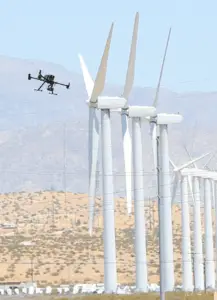 This is why the burgeoning drone industry is so exciting to wind power companies. It is estimated that a drone-equipped inspector can service up to 20 turbines each day, bringing the average inspection cost down to $500 per turbine. Moreover, automated flight profiles can replicate an inspection with machine precision month after month, year after year, to build a “time-lapse” profile of each turbine’s wear-and-tear. Visual and thermal imagery can be analyzed at machine speed to identify areas requiring a more human touch, thus cutting out some 90% of the human inspector’s workload. That’s a lot less rappelling down each turbine blade!
This is why the burgeoning drone industry is so exciting to wind power companies. It is estimated that a drone-equipped inspector can service up to 20 turbines each day, bringing the average inspection cost down to $500 per turbine. Moreover, automated flight profiles can replicate an inspection with machine precision month after month, year after year, to build a “time-lapse” profile of each turbine’s wear-and-tear. Visual and thermal imagery can be analyzed at machine speed to identify areas requiring a more human touch, thus cutting out some 90% of the human inspector’s workload. That’s a lot less rappelling down each turbine blade!
Before the drone pilots start sending their proposals to power companies, know this: it takes a very special drone to conduct wind turbine inspections. First, wind turbines tend to be built in windy areas, up to 40 knots of prevailing wind. That’s approaching “Gale Force” wind speeds! The drone needs to be able to hover in close proximity to structures, and withstand some gusts. Second, they need to have good GPS precision for both station-keeping and sensor orientation, well beyond 1 meter of accuracy. For most applications, this implies an RTK solution. Third, there will be some magnetic interference in the presence of such a large metallic and power-generating (with magnetized coils) structure, so the onboard navigation equipment needs some electromagnetic hardening. Finally, the sensors need to be high-definition daytime and infrared imagery to spot cracks and stress fractures from several meters.

DJI Matrice 300 with RTK
In addition to the drone, there will be some intensive information-processing software required for the gigabytes of data that each flight will generate. And a high-performance computer to run it. This isn’t your standard Adobe product line; we’re talking professional industrial applications like Scopito.
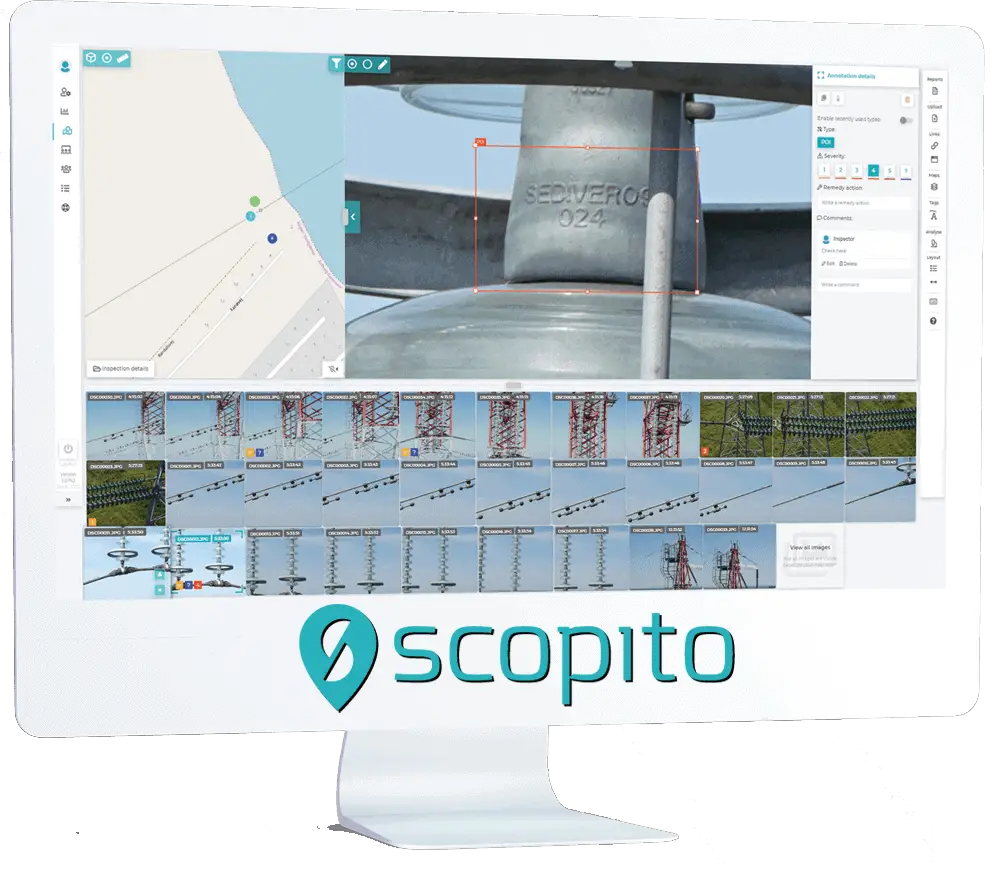
Scopito | Welcome to the future of visual inspections.
At Scopito, we are experts at digitizing your assets. Our platform uses automation and Machine Learning to derive all-important insights from your geospatial data. Over time, your historic inspection data will become the catalyst for powerful predictive maintenance.
Not to take the human out of the equation...
…a real estate agent might accept a novice drone pilot with a new Part 107 certification, but a power utility company with hundreds of millions of dollars invested into its wind farm will not. If you want to be a player in this industry, you are going to need some credentials and experience to be taken seriously. Prove to your client that, not only will you not damage his equipment with your drone, but you will also provide valuable data that will lower his operating costs year after year. And he will get the same service, every time, year after year. That is what he is getting from his rope-and-ladder inspectors, so that is the quality threshold that you have to meet or exceed.
Conclusion
Wind power is one of the fastest-growing energy sources in the world, and its main fuel source shows no signs of slowing down. So, asking the question, is wind power losing it’s appeal? I would maintain that no, wind energy is here to stay. There is a deep infrastructure between the power source and our homes, and the companies to provide us wind-generated electricity have enormous investment costs to contend with.
In the drone industry, we have a chance to make this investment more appealing to power utility companies, but we have to prepare ourselves with professional equipment and experience. Do your research and master your craft, and you can be one of those high-revenue drone pilots that is helping the environment.
How To Get Your FAA Part 107 Pilot Certification
If you are serious about making money with your drone, whether it be Real Estate, Aerial Inspections, etc., then you will need, from the FAA a 14 CFR Part 107 certification.
The best source for your training can be found by clicking on RemotePilot101. Jason Schappert is a pilot and author of 8 best-selling aviation flight training books. While studying and taking tests is not the most fun, Jason breaks it down into 10 easy to follow (at your own pace) video lessons. These lessons are straight and to the point giving you the exact knowledge, nothing less, nothing more than what you need to pass the exam. Additionally, he is continually updating the training to keep it relevant to any changes to FAA regulations. This membership is a 1-time subscription – for life! So when you’re 24 month renewal comes around, just sign in to RemotePilot101 and refresh your training.
Just remember, if you are flying commercially, you will need your Part 107 certification. It’s not hard, you can do it!




